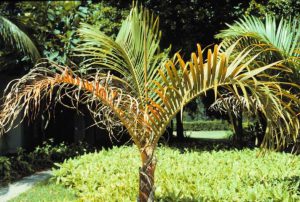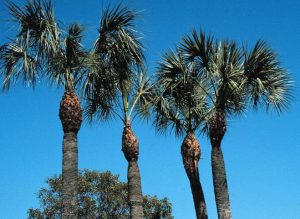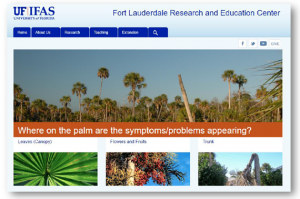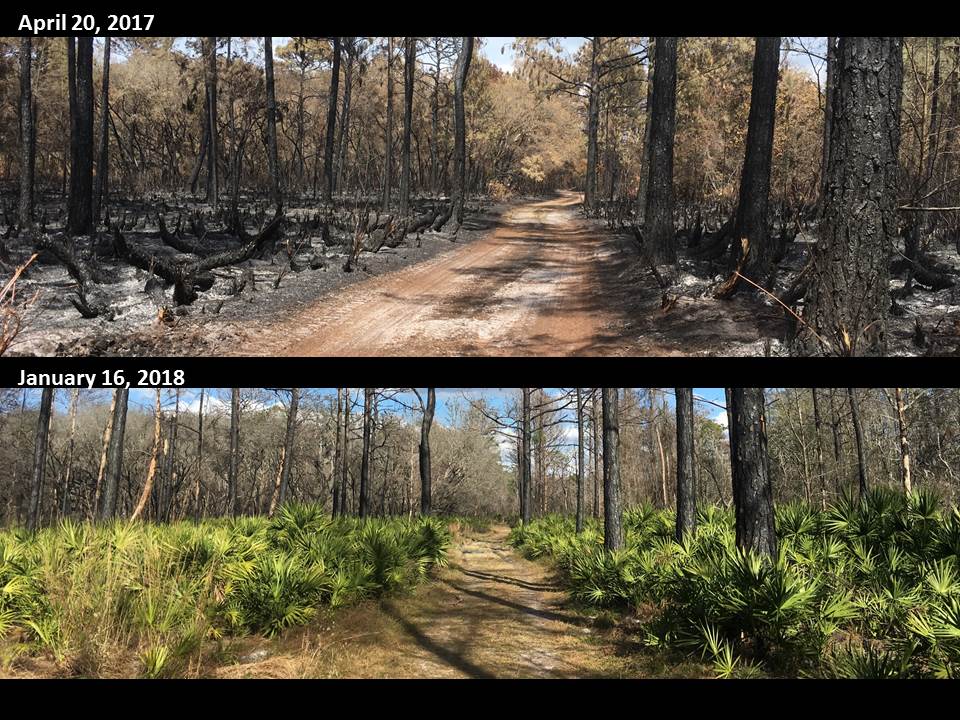Does your palm have ugly yellowing leaves?

STOP!!!!
Put down the pruning equipment and step away from the palm.
When NOT to prune a palm –
You can’t prune away a palm nutrient deficiency. In fact, pruning off a palm’s discolored leaves will only make the problem worse. (I’ll explain why in a moment.)
Likewise, you can’t prune away a palm disease (like fusarium wilt, etc.) – BUT – you can potentially spread certain palm diseases from sick plants to healthy ones via infected pruning equipment.
Ultimately, there are no “instant fixes” when a palm isn’t looking its best (other than cutting it down.) You simply can’t prune a palm back into good health.
Want your palm to look healthier? You’ll need to figure out why it looks unhealthy and address the underlying issue(s).
Some issues, such as nutrient deficiencies, can be corrected. (However, re-growing a full, healthy, green canopy of leaves can be a slow process – sometimes taking years.) On the other hand, some palm diseases are incurable and contagious, and the best strategy will be careful removal & disposal to contain the spread.
The good news? UF/IFAS Extension has the information you need to help diagnose your palm problem, and develop the right action plan. (At the bottom of this post, you’ll find some helpful resources and contact information.)
“Can’t I just remove the ugly yellow leaves?”
Typically, the ONLY reason you should consider pruning your palm is to remove fully brown, dead fronds.‡
“What about “hurricane pruning?”
Definitely not.
Here are a few reasons why:

Image source – https://edis.ifas.ufl.edu/ep443
1) Removal of living fronds can often result in weak, narrowed growth of the trunk (sometimes known as “pencil-pointing”). This narrow growth point is actually more susceptible to breakage in high winds.
(TIP: Just say, “NO WAY!” to the ironically misnamed practice of ‘hurricane pruning’ palms.)
Side-note: Removal of too many fronds may also increase a palm’s vulnerability to cold damage.

Image source – http://edis.ifas.ufl.edu/pp139
2) Removing living fronds also greatly increases the risk of spreading fungal, bacterial, or viral pathogens from tree to tree – especially if pruning equipment is not thoroughly disinfected between each tree.

Image source – http://edis.ifas.ufl.edu/ep273
3) Nutrient deficiencies and diseases will often cause distinct patterns of color changes and/or leaf deformities. Removing those “ugly leaves” makes it much more difficult to correctly diagnose the problem.

Credit: T. K. Broschat, UF/IFAS – Source – http://edis.ifas.ufl.edu/pdffiles/ep/ep26600.pdf
4) Even worse, the removal of green or yellow leaves can actually cause severe nutrient deficiencies, or make existing issues worse. The longer the deficiency goes uncorrected, the more difficult it will be to fix.
Some interesting background re: palm biology –
When a palm is attempting to grow new fronds, if the soil is unable to provide the necessary nutrients to make a new leaf, guess where the plant can withdraw them from?
That’s right! Palms can actually pull certain nutrients out of the oldest leaves – basically “cannibalizing” the oldest leaves – in order to build healthy new ones.
(Isn’t nature fascinating?)
If the bottom leaves of your palms frequently turn yellow before turning brown – that’s the reason why! Certain nutrients are being extracted for the benefit of new growth.
But what happens if you prematurely trim off those lower leaves while they’re still green or yellowing?
The palm suddenly loses a critical source of stored nutrients. To keep growing new leaves, your over-pruned palm will now start scavenging nutrients from higher in the canopy – i.e. from the remaining healthy green leaves.
The result?
The palm’s (previously) healthy green leaves are now serving as the food supply to support the new growth. As their nutrients get funneled away, these previously healthy, green leaves will begin to turn yellow a…
HEY – put down that pole saw! Haven’t you been paying ANY attention?
Continually pruning away those yellow, sickly leaves can actually drain the nutrient reserves that a palm may have spent decades accumulating. To put it simply…
By removing the “ugly” fronds, you’re effectively doing the OPPOSITE of fertilizing your plant – you’re taking away nutrients!
Summary – While yellowing leaves may not look appealing, it is important to address a palm’s nutrient deficiency, rather than trying to “prune away the problem.”
To read more about the UF/IFAS recommendations on palm pruning, as well as the importance of properly cleaning pruning tools, check out the publication: “Pruning Palms” http://edis.ifas.ufl.edu/ep443
Side-note – Some palms don’t actually require ANY pruning. The above publication also mentions that certain palms are referred to as “self-cleaning” – meaning the old leaves naturally fall away from the trunk when ready. (Here in central FL, Washingtonia palms are one of the more commonly encountered examples.)
The following publications contain recommendations from UF/IFAS on proper palm fertilization and nutrient deficiencies:
“Nutrient Deficiencies of Landscape and Field-Grown Palms in Florida” – http://edis.ifas.ufl.edu/ep273
-and-
“Fertilization of Field-Grown and Landscape Palms in Florida” – http://edis.ifas.ufl.edu/ep261
IMPORTANT – Certain rapid patterns of yellowing or leaf decline can be telltale indicators of palm disease, rather than a nutrient deficiency. Likewise, cold-sensitive palms may exhibit leaf damage/discoloration after cold weather that could be confused with disease or nutrient deficiencies. UF/IFAS has the information you need to help correctly diagnose your landscape plant issues and develop the right plan of action.
Don’t know how to contact your local UF/IFAS Extension team? No problem – Click this link to find your local UF/IFAS Extension office. http://sfyl.ifas.ufl.edu/find-your-local-office/

NOTES:
*Removal of palm flower/fruit stalks is optional, but generally considered ok, as long as clean tools are used.
‡ There are a handful of curious palm species, such as saw palmetto, which are naturally adapted to re-growing their foliage after periodic wildfires. These unique plants can withstand severe periodic pruning without any negative effects. They can also potentially be thousands of years old.

(Note: Choosing the “right plant, right place” can help avoid issues like the chronic nutrient deficiencies described above… For some helpful tips and online plant selection guides, check out this previous post on choosing the “right plant for the right place.”)
Is your landscape Water-Wise?
Each year, the Tampa Bay Community Water-Wise Awards Program seeks to recognize residents and businesses from across the tri-county Tampa Bay region (Pasco, Pinellas, and Hillsborough) that have created outstanding examples of water-efficient Florida-Friendly Landscapes.
What are some features that could make a landscape the next “water-wise” winner?
- Plant selection – “Right plant, right place”
- Efficient irrigation / “smart” irrigation / hand-watering only as needed
- Attractive design / “curb appeal” / fits community aesthetics
- Appropriate use of mulch, plants, and/or groundcovers
- Minimizes runoff
- Well-maintained
- Avoids invasive plants
In other words… if your landscape helps destroy the myth that attractive FL landscapes require a lot of water, fertilizer, and pesticides – you could be the next winner!
About the Author: As the Florida Friendly Landscaping (FFL) Program Coordinator in Pasco County, Frank works with the residents, homebuilders, and businesses of Pasco to achieve attractive, resilient yards and communities while reducing over-reliance on irrigation, fertilizer, and pesticides. Through an innovative collaboration with Pasco County Utilities, Frank provides on-site assistance to individuals and communities identified as high water users. He can be reached at (813)929.2716.
Thirsty for more FFL knowledge? Check out some of my previous posts!
Seeking solutions for a difficult landscape situation? Ask UF/IFAS Extension – We’ve got information for you!
Have an idea for a future post? Let me know at fgaldo@ufl.edu
About UF/IFAS Extension: UF/IFAS Extension serves as a source of non-biased, research-based information for the residents, businesses, and communities of Florida, providing educational materials and programs for adults and youth. We proudly “provide solutions for your life.”
Come learn at one of our workshops! Check out our Eventbrite page for a list of upcoming events: bitly.com/eventbritepasco
(Not in Pasco County? Not a problem! Click here to find your local UF/IFAS Extension office!)
by Frank Galdo
UF/IFAS Extension Is An Equal Opportunity Institution.
 0
0

